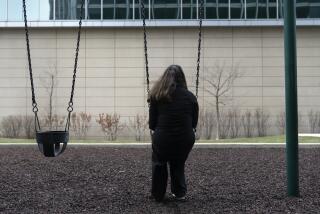Mental illness struck one in five U.S. adults in 2010: Report
- Share via
One in five adults in the U.S. had a mental illness in 2010, with people ages 18 to 25 having the highest rates, according to a national survey.
The report from the Substance Abuse and Mental Health Services Administration’s National Survey on Drug Use and Health, released Thursday, includes information from 68,487 completed surveys about mental illness (as defined by the American Psychiatric Assn.’s Diagnostic and Statistical Manual of Mental Disorders-IV) and substance abuse among adults and children. Rates have remained fairly stable since 2009, with only a slight uptick in overall numbers.
Among the highlights, people in the 50-plus age bracket had the lowest incidence of any mental illness (14.3%), while those ages 18 to 25 had the highest, at 29.9%. Women had higher rates than men: 23% versus 16.8%
When broken down by racial and ethnic groups, the highest rates of mental illness were seen among people who reported two or more races (25.4%), followed by whites (20.6%), blacks (19.7%), Native Americans or Alaska natives (18.7%), Hispanics (18.3%) and Asians (15.8%).
About 5% of adults in the U.S. had a serious mental illness in 2010, a slightly higher number compared to 2009 (4.8%). That 18- to 25-year-old age group again had the highest incidence at 7.7%, and those 50 and older had the lowest at 3.2%. Women again outpaced men, 6.5% to 3.4%. Those with a serious mental illness have trouble functioning, which affects their key life activities.
When broken down by racial and ethnic groups, the highest rates of serious mental illness occurred among adults who reported two or more races (9.3%), followed by Native Americans or Alaska natives (8.5%), whites (5.2%), Hispanics (4.6%), blacks (4.4%), Asians (2.6%) and native Hawaiians or other Pacific Islanders (1.6%).
“Mental illness is not an isolated public health problem,” Substance Abuse and Mental Health Services administrator Pamela Hyde said in a news release. “Cardiovascular disease, diabetes, and obesity often co-exist with mental illness and treatment of the mental illness can reduce the effects of these disorders.”
The report also found that 39% of people who had any mental illness obtained mental health services, and among those with a serious mental illness, 60.8% received help.
Mental illness can lead to thoughts of suicide, and in 2010 8.7 million people thought seriously about taking their own lives. In that group, 2.5 million people made plans to kill themselves, and 1.1 million attempted suicide.
Substance abuse sometimes goes hand in hand with mental illness; those who had any mental illness or a serious mental illness had much higher substance abuse or dependence rates (20%) compared to those who didn’t have a mental illness (6.1%).
Depression was an issue among children ages 12 to 17. Almost 2 million people in that age bracket had a major depressive episode in 2010 that lasted at least two weeks. Those who had such an episode had more than twice the rate of using illicit drugs than their peers who didn’t have a period of severe depression.
“Today’s report ... provides further evidence that we need to continue efforts to monitor levels of mental illness in the United States in order to effectively prevent this important public health problem and its negative impact on total health,” Ileana Arias of the Centers for Disease Control and Prevention said in the release.
More to Read
Sign up for Essential California
The most important California stories and recommendations in your inbox every morning.
You may occasionally receive promotional content from the Los Angeles Times.










